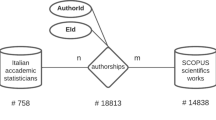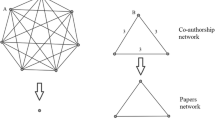Abstract
We analyse the co-authorship networks of researchers affiliated at universities in Turkey by using two databases: the international SSCI database and the Turkish ULAKBIM database. We find that co-authorship networks are composed largely of isolated groups and there is little intersection between the two databases, permitting little knowledge diffusion. There seems to be two disparate populations of researchers. While some scholars publish mostly in the international journals, others target the national audience, and there is very little intersection between the two populations. The same observation is valid for universities, among which there is very little collaboration. Our results point out that while Turkish social sciences and humanities publications have been growing impressively in the last decade, domestic networks to ensure the dissemination of knowledge and of research output are very weak and should be supported by domestic policies.
Similar content being viewed by others
References
Adams, J. D., Black, G. C., Clemmons, J. R., Stephan, P. E., (2005). Scientific teams and institutional collaborations: Evidence from U.S. universities (1981–1999), Research Policy, 34: 259–285.
Almeida, P., Kogut, B., (1998). Localization of Knowledge and the Mobility of Engineers in Regional Networks, Management Science, 45: 905–917
Butler, L., (2003). Explaining Australia’s increased share of ISI publications: The effects of a funding formula based on publication counts. Research Policy 32, 143–155.
Chen, C. and Hicks D., (2004). Tracing knowledge diffusion, Scientometrics, 59: 199–211.
Callon, M., (1991). Vers des archipels de la science, Science et Technologie, 34: 66–69.
Glänzel, W., Schlemmer, B. (2007). National research profiles in a changing Europe (1983–2003): An exploratory study of sectoral characteristics in the Triple Helix, Scientometrics, 70: 267–275.
Gomez, I., Fernandez, M. T., Sebastian, J., (1999). Analysis of the structure of international scientific cooperation networks through bibliometric indicators. Scientometrics, 44: 441–457.
Gülgöz, S., Yedekçioǧlu, Ö. A., Yurtsever, E., (2002). Turkey’s output in social science publications, Scientometrics, 55: 103–121.
Hicks, D., (1999). The difficulty of achieving full coverage of international social science literature and the bibliometric consequences, Scientometrics, 44: 193–215.
Jaffe, A. B., Trajtenberg, M., Henderson, R., (1993). Geographic localization of knowledge spillovers as evidenced by patent citations, The Quarterly Journal of Economics, 108: 577–598.
Kabasakal, H., Bodur, M., (2006). Leadership and Culture in Turkey: A Multi-faceted Phenomenon, In: Chhokar, J., Brodbeck, F., R. House (Eds), Managerial Cultures of the World: A GLOBE Report of In-depth Studies of the Cultures of 25 Countries. Lawrence Erlbaum Associates, Mahwah, NJ.
Katz, J. S., Martin, B. R., (1997). What is research collaboration? Research Policy, 26: 1–18.
Lee, S., Bozeman, B., (2005). The impact of research collaboration on scientific productivity, Social Studies of Science, 35: 703–772.
Luukkonen, T., Persson, O., Sivertsen, G., (1992). Understanding the patterns of international scientific collaboration, Science, Technology, & Human Values, 17: 101–126.
Melin, G., (2000). Pragmatism and self-organization research collaboration on the individual level”, Research Policy, 29: 31–40.
Merton, R. K., (1973). The Sociology of Science: Theoretical and Empirical Investigations. Chicago: University of Chicago Press.
Moody, J., (2004). The structure of a social science collaboration network: Disciplinary cohesion from 1963 to 1999, American Sociological Review, 69: 213–238.
Norgaard, R., (2004). Learning and knowing collectively, Ecological Economics, 49: 231–241.
Otte, E., Rousseau, R., (2002). Social network analysis: A powerful strategy, also for the information science, Journal of Information Science, 28: 441–453.
Persson, O., Melin, G., Danell, R., Kaloudis, A., (1997). Research collaboration at Nordic universities, Scientometrics, 39: 209–223.
Singh, J., (2005). Collaborative networks as determinants of knowledge diffusion patterns, Management Science, 51: 756–770.
Solla Price, D., Beaver, D., (1966). Collaboration in an invisible college, American Psychologist, 21: 1011–1018.
Sonnenwald, D. H., (2007). Scientific collaboration: A synthesis of challenges and strategies, Annual review of information Science and Technology, 41 (forthcoming).
Sorenson, O., Fleming, L., (2004). Science and the diffusion of knowledge, Research Policy, 33: 1615–1634.
Uzun, A., (1998). A scientometric profile of social sciences research in Turkey, International Information & Library Review, 30: 169–184.
Wagner, C.S., (2006). International collaboration in science and technology: Promises and pitfalls, In: Box, L., Engelhard, R., (Eds), Science and Technology Policy for Development: Dialogues at the Interface. Anthem Press, London.
Wagner, C. S., Leydesdorff, L., (2005a). Mapping the network of global science: Comparing international co-authorships from 1990 to 2000, International Journal of Technology and Globalisation, 1: 185–208.
Wagner, C. S., Leydesdorff, L., (2005b). Network structure, self-organisation, and the growth of international collaboration in science, Research Policy, 34: 1608–1618.
Wulf, W. A., (1993). The collaboratory opportunity, Science, 261: 854–855.
Yurtsever, E., Gülgöz, S., (1999). The increase in the rate of publications originating from Turkey, Scientometrics, 46: 321–336.
Zitt, M., Bassecoulard, E., Okubo, Y., (2000). Shadows of the past in international cooperation: Collaboration profiles of the top five producers of science, Scientometrics, 47: 627–657.
Author information
Authors and Affiliations
Corresponding author
Rights and permissions
About this article
Cite this article
Gossart, C., Özman, M. Co-authorship networks in social sciences: The case of Turkey. Scientometrics 78, 323–345 (2009). https://doi.org/10.1007/s11192-007-1963-x
Received:
Published:
Issue Date:
DOI: https://doi.org/10.1007/s11192-007-1963-x




